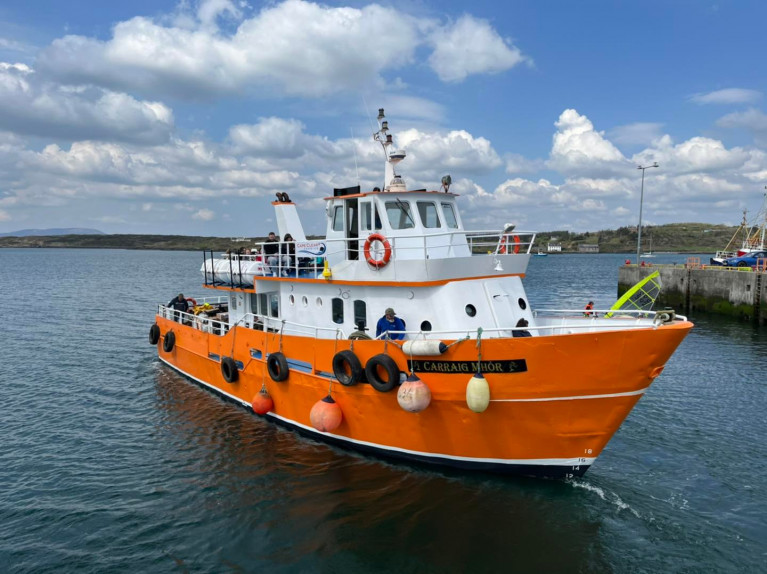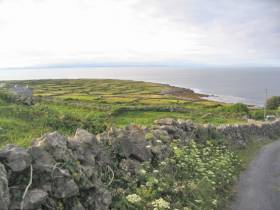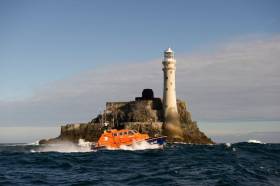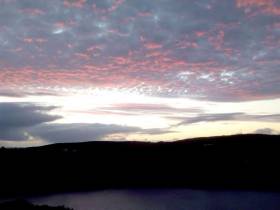Displaying items by tag: Cape Clear
Baltimore RNLI Evacuates Woman from Cape Clear Island in Choppy Seas
A woman living on Cape Clear Island off the coast of West Cork was evacuated by the Baltimore RNLI on Wednesday night. The Irish Coast Guard had requested the medical evacuation, and the volunteer lifeboat crew launched their all-weather lifeboat at 11:07 PM. The Baltimore all-weather lifeboat crew arrived at North Harbour on Cape Clear Island at 11:33 PM, where the casualty was assessed by some of the Casualty Care lifeboat crew members. After the assessment, she was transferred via stretcher onboard the lifeboat and taken back to Baltimore station, where she was handed over to the HSE Ambulance crew.
The call out was made under fresh conditions with a southwesterly force 5-6 wind and a choppy sea, but the seven-strong volunteer crew onboard the lifeboat, including Coxswain Aidan Bushe, Mechanic Cathal Cottrell, and crew members Micheal Cottrell, Colin Whooley, Stuart Musgrave, David Ryan, and Don O’Donovan, managed to complete the mission safely.
Kate Callanan, Baltimore RNLI Volunteer Lifeboat Press Officer, said, “Baltimore RNLI often provides medical evacuations to residents and visitors to the islands off the coast of West Cork, including Cape Clear, Sherkin, and Heir. If you find yourself in a medical emergency while on an island, call 999 or 112.”
Cape Clear Ferries has announced its summer schedule for West Cork, taking in Baltimore, Cape Clear Island, The Fastnet Rock and Schull.
The announcement comes amid considerable excitement at the launch of the newest addition to their fleet – the ‘Carraig Aonair’ (formerly Spirit of Doolin).
The Carrig Aonair is certified to carry 200 passengers to Ireland’s most southerly point. Most importantly, the ferry is weatherproof and built to withstand unpredictable Irish weather conditions.
Just in time for summer, visitors can circumnavigate the iconic Fastnet Rock Lighthouse in the comfortable surrounds of the new ferry – with panoramic 360 views from both inside and out - with large saloon windows to enjoy the view and seating for 100 passengers inside.
 The Launch of Cape Clear Ferries’ new-200 passenger fast ferry (the Carraig Aonair). The multi-award-winning ferry service takes in Baltimore, Cape Clear Island, The Fastnet Rock and Schull with panoramic 360 views from both inside and out Photo: Miki Barlok
The Launch of Cape Clear Ferries’ new-200 passenger fast ferry (the Carraig Aonair). The multi-award-winning ferry service takes in Baltimore, Cape Clear Island, The Fastnet Rock and Schull with panoramic 360 views from both inside and out Photo: Miki Barlok
The tour has also been named among the top tours in Ireland by National Geographic and has topped the bill as an outstanding West Cork Maritime Tourism experience. Fáilte Ireland has also featured footage of one of its ferries rounding the Fastnet Rock in its national and international television ads.
Speaking in relation to the launch of the summer schedule, Karen Cottrell from Cape Clear Ferries said:
“There is always great excitement and anticipation ahead of our regular schedule launches at the beginning of the summer season, but this year we are thrilled to have the option to provide faster and more frequent tours around the famous Fastnet Rock – the tallest and widest rock lighthouse in Ireland and the UK.
“This offers a brilliant backdrop for great family adventures - sailing around the towering rock, savouring its rich history and magnificent location, often seeing whales, dolphins and basking sharks en route.
“Passengers can also visit the picturesque Cape Clear Island and the Queen of Carbery’s Hundred Isles, while those who want to take the tour as the sun sets can avail of our hugely popular twilight tours, which return again this year.
Meanwhile, a sister company, Cork Harbour Cruises, was established to showcase the coastal areas along Cork City, passing Blackrock Castle and on to Cobh, (and recently named ‘Best New Business’ at this year’s Cork Business Association Awards) also continues its scenic harbour tours. Docked at Custom House Quay at the centre of Cork City, it will also welcome passengers on board throughout the summer with corporate packages and twilight tours available.
Baltimore RNLI Lifeboat Provides Second Medical Evacuation from Irish Island Within a Week
Baltimore RNLI was called out to provide a medical evacuation yesterday evening (Tuesday 25 April) from Cape Clear Island off the coast of West Cork.
Last week the crew performed a Medvac from Sherkin Island, as Afloat reported.
The volunteer lifeboat crew launched their all-weather lifeboat at 5.29pm, following a request from the Irish Coast Guard to provide a medical evacuation for a man on the island. The crew were already gathered at the lifeboat house in Baltimore at the time the request came in as they were about to go out on exercise.
The Baltimore all-weather lifeboat crew arrived at North Harbour on Cape Clear Island at 5.49pm and after the casualty was assessed by the Casualty Care lifeboat crew member, he was transferred onboard the lifeboat. The lifeboat departed Cape Clear Island at 5.55pm and returned to the station in Baltimore arriving at 6.25pm. The casualty was then handed over to the care of HSE Ambulance crew.
There were seven volunteer crew onboard the lifeboat, Coxswain Pat Collins, Mechanic Jerry Smith and crew members Eoin Ryan, Paul Synott, Emma Lupton, Emma Geary and Kieran Collins. Conditions during the call-out were good with a south easterly force 4-5 wind and a slight sea swell.
Speaking following the call out, Kate Callanan, Baltimore RNLI Volunteer Lifeboat Press Officer said: ‘This is the second medevac carried out from an island within the past week. Baltimore RNLI provides a vital service to those living, working or holidaying on an island who are in need of medical assistance. If you find yourself in a emergency whilst on an island call 999 or 112.’
New Wild Atlantic Way Ferry Sets Sail for Cape Clear Island
A ferry acquired by Cape Clear Ferries set off on its maiden crossing to the West Cork island yesterday and under the new name of Carraig Mhór, writes Jehan Ashmore.
The Baltimore based operator's latest addition saw Carraig Mhór which has lounges and outdoor viewing decks, enter service on the 2pm sailing from the harbour pier.
In addition to the Baltimore-Cape Clear Island route, the operator also serves the island from Schull, further to the west on the Mizen Peninsula.
The 96 passenger ferry previously named the Happy Hooker, had served a long career serving the Aran Islands for Doolin2Aran Ferries, having been built in 1989.
Afloat researched that the Happy Hooker had departed Rossaveel, Connemara in January and this led to a delivery voyage along the western seaboard to the ferry's new Cork coast homeport.
In order to prepare the 19.8m ferry for Cape Clear Ferries, this involved months of work carried out by their crew and by Oldcourt Boats Ltd located on the nearby River Ilen. Gone has the blue hull colour of the Doolin-based operator, as the distinctive twin funnelled Carraig Mhór emerged also with a stricking orange hull and white superstructure reflecting the ferry's new owner.
The same livery scheme is sported by Cailín Óir, a 100 passenger excursion vessel that had also been a Cape Clear ferry is run by the company's Cork Harbour Cruises which launched in 2021. Such cruises resumed this season having started during the busy Easter Bank Holiday weekend.
Returning to Carraig Mhór, which has joined another company fleetmate, the 94 passenger ferry Dún an Óir II that serves the island which is three and a half miles long by one and a half miles wide. The ferries offer the opportunity to do whale and dolphins spotting off the island's rugged coastline.
Afloat tracked the ferry's route passage which offers the added bonus of passing Sherkin Island to reach the Cape Clear where the island is rich in archaeology history with ancient standing stones, Bronze Age monuments and traditional stone walls.
Cape Clear (Oileán Chléire) has a permanent Irish speaking population of 130. During the summer this number increases significantly, noting there is an Irish Language Summer School.
Also the summer brings a lively social and traditional music scene with local joined by visitors.
Facilities on the West Cork island include restaurants and pubs, a range of accommodation including a youth hostel, yurt village, campsite, various guesthouses and a choice of holiday homes.
A Baltimore-Cape Clear Cruise is also available plus further offshore, is an excursion cruise around the Fastnet Rock Lighthouse (“Teardrop of Ireland”) which is also available from Schull.
These tours are based as the following: Fastnet Day Tour, Sunset/Twilight Tours and Direct Fastnet tours and subject to weather conditions.
Asides tourism, the company is a vital lifeline for islanders bringing cargoes but only operates out of Baltimore.
Cape Clear Ferries to Operate a New Service in Cork Harbour
The iconic orange and white colours of Cape Clear Ferries will shortly become a familiar sight around Cork Harbour with the launch of Cork Harbour Cruises on Sunday 20th June next.
The Cailín Óir vessel has recently been upgraded to cater for 100 passengers with additional popular upper deck seating for panoramic 360° views of the spectacular harbour.
The service will operate from both Cork City Centre and Crosshaven to offer a range of excursions including a new service to Spike Island which is one of Ireland’s most up and coming visitor attractions. Operating from Crosshaven this 30-minute trip offers scenic views and commentary en route to the historic Island and its imposing fortifications.
The Cailín Óir can cater for young and old alike with no age restrictions and even on rainy days its large windows ensure that the sights can be enjoyed in perfect comfort. Refreshments will be available on board and Cork, being the storytelling capital of Island, will also feature stories and anecdotes from the area’s rich maritime history.
Operating from the Marina in Cork City the service offers mini after lunch cruises together with a longer excursion into the Harbour. Since Cork is a bustling harbour with a great range of activities, wildlife, scenery and weather conditions no two days will be quite the same.
Evening sunset tours are perhaps the best way to end a perfect summer’s day.
The service will also cater for private groups and parties.
Cape Clear Distillery Produces its First Bottles of Offshore Island Gin
Cape Clear Island Distillery, Ireland’s newest and only offshore Island distillery confirmed its first distillations last week with the first bottles of gin produced on Thursday 7th November last.
Its been a turbulent few months for the new operation which has significant local support on this small Gaeltacht Community at Ireland most southwestern extreme. Funded mostly by private local investors with Údaras na Gaeltachta support the distillery is based in a seashore premises formerly used as a hatchery. With planning permission already in place for a full-scale whiskey distillery, this is the first step in an ambitious plan to develop the unique coastal site on a phased basis.
With so many gins currently on the market, an enormous effort has been expended to develop a quality gin that truly reflects the maritime nature of the Island and its landscape. It took a team of local enthusiasts working with new product developer and distiller Ruth Court over 6 months to finally achieve a distinctive recipe that all are genuinely very proud off. The ingredients include laminaria digitata, fuschia and honeysuckle and the result is described as a classic, bracing and full flavoured gin with the fresh hand foraged botanicals complimenting but not overpowering the juniper base.
"The first 1,000 bottles are being produced under a unique label, marked 1 to 1,000"
The first 1,000 bottles are being produced under a unique label, marked 1 to 1,000. The distinctive 3 Sq, Miles brand was developed by Terry Green of www.terrygreendesign.com to reflect the surrounding seascape.
Cape Clear Distillery will shortly reopen to investors for subsequent phases and also offers an innovative €100 5% preference share orientated towards ‘fun’ investors. These will, for the most part, be redeemed against products from the company and are described as ‘super gift vouchers’ that appreciate in value the longer they are held. The company also markets distinctive glassware and other products.
Opportunities For Clean Energy In Ireland’s Island Communities
Island life, in all its challenges, also harbours opportunity for the transition to renewable energy — and the people of the Aran Islands are putting that into practice.
Juliette Gash reports for RTÉ Radio 1’s Morning Ireland from the Galway Bay island group, where the local energy co-operative set an ambitious target to be self-sustainable for energy generated from the wind, waves and sun by 2022.
While they may not hit 100% by that date, they have made progress that outs the rest of Ireland to shame.
But that should be no surprise when Ireland’s island communities have long been ahead of the curve when it comes to green energy — particularly Cape Clear in West Cork, which until 1993 had the world’s first integrated wind energy system.
Listen to the full RTÉ Morning Ireland report below:
A high-profile royal visit is set to bring out the orange in Cape Clear Ferries’ orange-and-white branding next weekend.
The company’s new fast ferry from Schull and Baltimore to Cape Clear Island will take a different route next Friday 14 June as it transports the Dutch royal family on a special trip from Cork city via Cobh to Crosshaven in Cork Harbour.
Séamus Ó Drisceoil, manager of Cape Clear Ferries, expressed his delight that Dún na Séad II would be considered suitable for such an event.
“Our company has invested and reinvested consistently over the years to raise our standards and we feel that this is an impressive and merited endorsement both of our newest ferry and also our dedicated and hardworking team,” he said.
“Karen Cottrell along with crew members Shane Ó Drisceoil, Cathal Cottrell, Niamh Ní Dhrisceoil and Iain O’Driscoll will be present on the day to welcome on board the Royal Highnesses, King Willem-Alexander and Queen Máxima, as well as Uachtarán na hÉireann, Michael D Higgins and other dignitaries.”
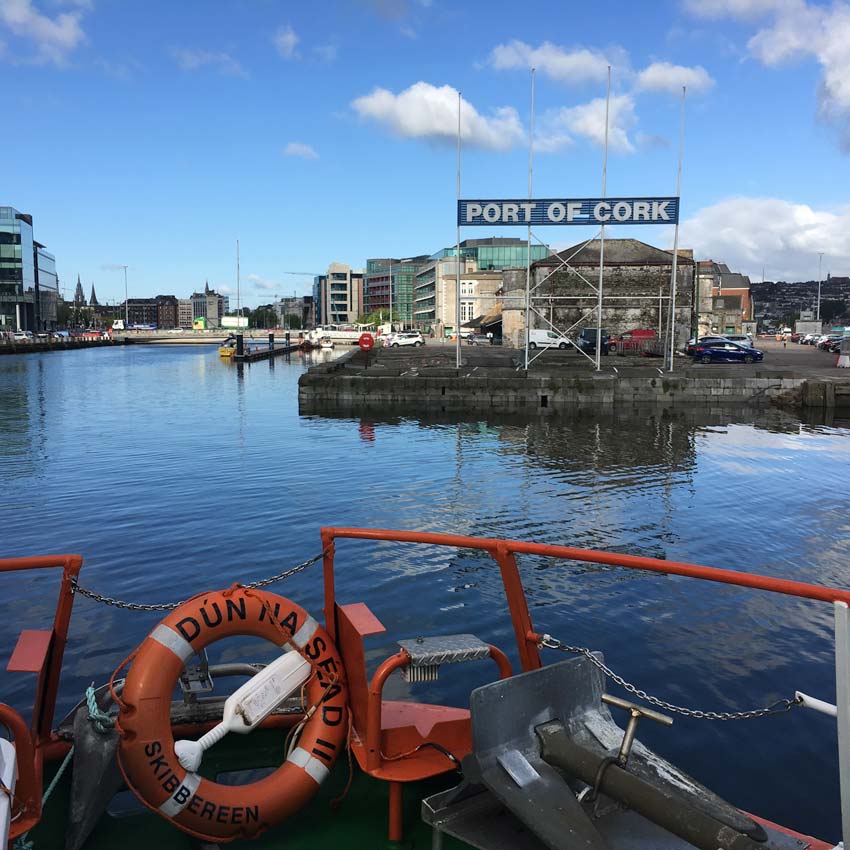
There will be a heavy security presence around the royal ‘boatercade’ with no other unapproved vessels permitted on the river during the visit.
Karen Cottrell said: “We are working very hard to make good of this significant upgrading of the ferry fleet in West Cork by promoting award-winning tours around the iconic Fastnet Rock Lighthouse.
“This is an outstanding natural and historical landmark off the West Cork coast and of course all our tours are via Cape Clear Island also known as ‘The Gateway to the Fastnet’.
“We will be delighted to welcome the royal couple and other dignitaries on board, but in reality all our passengers are special to us.
“In a few weeks’ time we will also welcome on board the chief of the O’Driscoll Clan for their annual visit to Cape Clear Island,” Cottrell added.
Medevac From Cape Clear Island For Baltimore Lifeboat
Baltimore RNLI carried out a medevac last night (Friday 7 June) from Cape Clear Island off the coast of Baltimore in West Cork.
The volunteer crew launched their all-weather lifeboat at 6.20pm, following a request from the Irish Coast Guard to provide medical assistance and evacuation to an islander living on Cape Clear.
The lifeboat arrived at North Harbour in Cape Clear within 20 minutes, and was headed back to the mainland with the casualty on board after just a two-minute turnaround.
By just after 7pm the casualty had been handed over to the care of a HSE ambulance crew in Baltimore.
Conditions at sea during the call out were good, with a north-westerly Force 4-5 wind, a one-metre sea swell and very good visibility.
Speaking following the callout, lifeboat press officer Kate Callanan said: “If you find yourself in a medical emergency whilst on an island call 999 or 112 and explain to the operator what the nature of the call is.
“The operator will then make sure that the call is directed to both the coastguard and the National Ambulance Service. We wish the casualty a full recovery.
“Our thoughts today are also with the family, friends and colleagues of the crew members of the French lifeboat service SNSM who lost their lives yesterday during a rescue.”
There were seven volunteer crew onboard the lifeboat on this callout: coxswain Kieran Cotter, mechanic Cathal Cottrell and crew members Jerry Smith, Kieran Collins, Pat Collins, Colin Rochford and David Ryan. Assisting at the boathouse in Baltimore were Gerald O’Brien, Aidan Bushe and Don O’Donovan.
Cape Clear Island Seeks Dark Skies Status
Cape Clear Island off the coast of West Cork is seeking to become one of only 22 Dark Sky sites worldwide officially recognised by the IDA ( International Dark Sky Association). These sites are dedicated to stargazing and are increasingly hard to find because of the amount of light created by modern living which makes it harder to see and appreciate the true beauty and wonder of the night sky.
Cape Clear lying 8 miles off the coast, like the other sites is remote from towns, cities and busy roads and is an area of outstanding natural beauty. Already famous for ornithology and whales, dolphins and basking shark its pristine night sky is another fantastic natural resource the Island has to offer.
Dark Skies events provide opportunities to view the night sky with the naked eye accompanied by experienced guides and astronomers, sharing their knowledge and appreciation of the splendour above our heads and breathing new life into the rich folklore, tradition and history associated with the night sky.
The first Cape Clear Island Dark Skies event takes place over the weekend of Friday to Sunday, 22 to 24th May and includes both night time and day time events and with support from Blackrock Castle Observatory and Cork Institute of Technology. There will be a range of speakers led by Dr Niall Smith of CIT and night photographer Cian Walsh.
The event was inspired by Shane O’Neill a teacher in the Island national school, who, living on its south side became impressed with the clarity of the night sky, often seeing shooting stars, planets and even the International Space station moving across the sky. Keeping up with celestial events quickly became a passion and one which he should like to share with others.



























